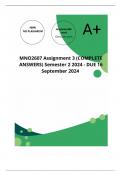,1. What would you classify as change agent methods used by
safety managers? (10)
Change agent methods used by safety managers are strategies or
techniques employed to implement and manage safety-related
changes within an organization. These methods aim to enhance
safety performance, comply with regulations, and promote a
safety culture. Here are some key methods:
1. Leadership and Vision: Safety managers often lead by
example, setting a clear vision for safety. They communicate
the importance of safety to all levels of the organization,
creating a shared understanding and commitment.
2. Training and Education: Implementing training programs
to educate employees about safety practices, regulations, and
emergency procedures. Continuous education helps keep
safety knowledge up-to-date and relevant.
3. Risk Assessment and Management: Conducting thorough
risk assessments to identify potential hazards and
implementing measures to manage or mitigate these risks.
This may involve regular inspections, audits, and safety
drills.
4. Communication Strategies: Using various communication
channels (meetings, newsletters, signage) to keep employees
informed about safety procedures, updates, and changes.
Effective communication fosters a culture of transparency
and engagement.
5. Employee Involvement: Engaging employees in safety
initiatives by involving them in safety committees, soliciting
feedback, and encouraging them to participate in safety
observations and reporting.
, 6. Change Management Techniques: Applying structured
approaches to manage change, such as the ADKAR model
(Awareness, Desire, Knowledge, Ability, Reinforcement) or
Kotter’s 8-Step Change Model. These techniques help
facilitate the adoption of new safety practices.
7. Safety Culture Development: Cultivating a positive safety
culture where safety is prioritized and embedded in daily
operations. This involves recognizing and rewarding safe
behavior and addressing unsafe practices promptly.
8. Policy and Procedure Updates: Regularly reviewing and
updating safety policies and procedures to reflect changes in
regulations, technology, and best practices. Ensuring that all
employees are aware of and understand these updates.
9. Incident Investigation: Analyzing incidents and near-misses
to understand their root causes and implementing corrective
actions to prevent recurrence. This approach helps in
continuous improvement of safety measures.
10. Performance Monitoring and Metrics: Establishing
key performance indicators (KPIs) and metrics to monitor
safety performance. Regularly reviewing these metrics helps
in assessing the effectiveness of safety initiatives and
identifying areas for improvement.
11. Technology and Innovation: Leveraging new
technologies and innovations to enhance safety measures.
This could include safety management software, wearable
technology, or automated systems for hazard detection.
12. Compliance and Audits: Ensuring adherence to safety
regulations and standards through regular audits and
inspections. Compliance helps in maintaining legal and
regulatory standards, reducing the risk of penalties.
13. Stakeholder Engagement: Collaborating with external
stakeholders, such as regulatory bodies, industry groups, and




